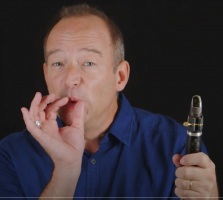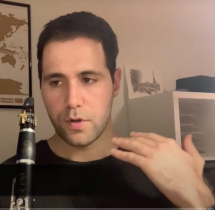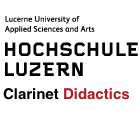Staccato (English)
The skills of staccato are largely identical to those described in the chapter articulation. On this page, fast staccato and double-tongue are discussed in more detail.
Contributions of the interviewees
- Michel Arrignon
- François Benda 1, 2
- Paolo Beltramini
- James Campbell
- Eli Eban
- Steve Hartman
- Sylvie Hue
- Gerald Kraxberger
- Seunghee Lee
- Harri Mäki
- Heinrich Mätzener 1, 2
- Ernesto Molinari
- Pascal Moraguès
- John Moses 1, 2
- Robert Pickup
- Thomas Piercy
- Frédéric Rapin
- Milan Rericha
- Ernst Schlader
- David Shifrin 1, 2
- Michel Westphal 1, 2, 3
Requirements for a well-responsive staccato
Embouchure and Airflow
In order for staccato passages to sound as good as legato passages (Frédéric Rapin), the interviewees mention the following indispensable requirements:
- The Embouchure remains as stable in staccato as in a sustained note or a legato passage.
- The basis of staccato is continuous Airflow and breath support, independent of the tongue movements. Fast staccati succeed better with agile air control (see learning video by Jean-François Philipp).
Simultaneous Control over three Functions of the Tongue
Italian "staccare" in a musical context means "to separate" individual notes by (short) pauses in articulation.
The tongue not only separates individual notes, it also performs important tone-forming functions after the articulation pause.
- The tip of the tongue articulates at the reed, it interrupts the vibration of the reed and releases it again. Furthermore, the position of the tip of the tongue influences intonation and timbre.
- The middle area of the tongue is involved in voicing, thereby influencing intonation and timbre, and regulating air velocity. Faster airflow is especially important for response in upper registers.
- The posterior region of the tongue and the soft palate shape the pharynx as a resonance chamber. Sound fullness is optimized when the intrinsic resonances in the oral cavity match the resonances in the instrument (see Jonston 1999[1]).
If these three functions of the tongue can be performed simultaneously and independently, a staccato with a sound quality equal to legato can be achieved. When articulating (1), therefore, only the tip of the tongue should move. The other areas (2 and 3) of the tongue perform their specific functions independently. The interview partners agree on the following:
- The path of the tongue between the blade and the rest position should be as small as possible.
- After the tongue is pulled back, i.e., after the reed vibration is released, the tongue remains as close as possible to the place where it touched the reed (John Moses, Thomas Piercy).
- The staccato movement of the tongue is not a "pushing" of the tongue against the reed. The tongue is pulled back from its point of contact with the reed, releasing the vibration of the reed (John Moses).
Didactic Ways - from "non legato" to "staccatissimo"
To separate a sequence of notes from each other, the tongue touches the reed with the smallest movement and the smallest pressure Michel Westphal. If the air pressure continues, the reed vibration is damped or stopped completely. In "non legato" the tip of the tongue touches the reed only very briefly. To change the mode of articulation from "non legato" to "portato" to "staccato" to "staccatissimo", i.e. to play with longer pauses in articulation, the moment of contact of the tongue with the reed is prolonged.
A first didactic principle is followed by Ernesto Molinari, Avrahm Galper, teacher of James Campbell:
- The starting point in teaching the staccato technique is legato. At the beginning, the notes are barely separated by the movement of the tongue; the tongue touches the reed only very briefly, so it hardly deviates from its tone-forming position. In small steps, the articulation pauses are then lengthened, and the tongue remains in contact with the reed for a correspondingly longer time. At each learning step, the focus remains on sound quality. The staccato must have the same sound quality as the legato.
- A second, complementary approach is practiced by James Campbell, François Benda:
From the beginning, a short articulation is trained. Longer pauses in articulation occur between tones, during which the tongue touches the reed. Pulling the tongue away from the reed releases the vibration of the reed for only a brief moment to allow a short tone to sound. Daniel Bonade (1962)[2] combines this technique with an exercise in coordinating tongue and finger movements. During the articulation pause - the tongue touches the reed, air pressure is maintained - the fingers prepare for the grip of the next note. Pulling the tongue away then allows the next note to sound, and the process is repeated.
In both ways, care must be taken to ensure that only the tip of the tongue is involved in articulation; the middle and back portions of the tongue remain involved in vowel and resonance formation. These functions must not be affected by the articulation movements.
Variations of Onset and Tone Ending
In order to produce a "drier staccato" and to stop the sound immediately, the area of contact between the tongue and the tip of the reed is increased downward until the vibration is completely damped while maintaining airflow (Heinrich Mätzener). The point of contact ("point d'impact") can also be between the reed tip and heart (Eli Eban, Sylvie Hue, Steve Hartman) can be selected, two to three millimeters below the leaf tip.
Also, depending on the pitch and the variant instrument, the optimal points of contact of the tip of the tongue with the reed vary. According to a larger resonance space in the oral cavity, it is recommended for lower registers, especially on the bass clarinet, to look for the point of contact further down, in the direction of the heart of the reed. In high registers, especially on the E-flat clarinet, a point of contact at the very tip of the reed gives better results (François Benda, Heinrich Mätzener).
The point of contact on tongue can also vary, ranging from a slightly larger area to a "dot" at the very front of the tip of the tongue to a spot just below it (Robert Pickup).
To make the sound decay more slowly, the tongue can touch the uppermost edge of the reed or a corner very lightly so that, given sufficient air pressure and air speed, the reed will continue to vibrate in quieter dynamics even while in contact with the tongue. Pulling back the tongue allows the reed to vibrate again in its full amplitude. When the tongue returns to the tip of the reed, the reed continues to vibrate with a dampened, or even decreasing, vibration. This technique imitates the staccato of a stringed instrument (Pascal Moraguès, Eli Eban). It follows the tradition of Leopold Mozart (1756)[3], who calls for a fading in "dal niente" and a fading out "al niente" at each tempo and on each note. In slower tempos, the end of the note can also be led to pianissimo with the breathing technique.
Depending on the musical context, it is appropriate to blow a single note even without tongue articulation, with a short or violent, or more subdued air accent. If the tempo permits, in a series of accented staccati the tongue articulation can be supported with air accents to round it off dynamically.
In a sequence of fast staccati, the first note can be articulated with air only, and the following note(s) with the tongue. This blends the parameters of dynamics and articulation, and according to the musical expression, the differentiated bowing technique of the string instruments can be imitated. David Shifrin compares the jumping of the tongue on a powerful air accent to the ricochet on a string instrument.
Fast Staccato
Simple Tongue

Michel Arrignon uses the term "détaché réflexe" for fast staccato. He uses it to describe a very rapid withdrawal of the tip of the tongue from the reed, which is not consciously controlled by the movement center in the brain. The movement is comparable to the reflexive withdrawal of the fingertips when they have touched a red-hot object.
For the success of a fast staccato, the prerequisites as mentioned above apply:
- Stable embouchure
- The tongue is directed forward/upward, toward the upper incisors.
- The tongue performs the smallest possible movements
- The tongue movements are based on the air conduction.
Learning Steps according to Jean-François Philipp
- Start from a legato, separate the individual notes only very slightly from each other (French "louré", German "non legato").
- First join groups of two fast, energetic staccati with a generous breath impulse. Strengthen the tongue muscles in this way, increasing their agility. Place the breath pulse on the first note (counterpunctuated or Lombard rhythm), then also on the second note (dotted rhythm).
- Be sure to make the smallest possible movements, keeping the tip of the tongue very close to the reed at all times. Work in this way in all registers.
- Increase the tone groups, combine the tongue movements with different interval sequences. Tongue movements are always based on active air control.
- Variation: articulate the first note into a group of fast staccati using only the air. This exercise also serves to control the position of the tongue (very close to the reed) and its smallest possible movement.
Double tongue

In the double tongue technique, articulation movements are made alternately with the tip of the tongue at the front of the reed, and with the back of the tongue at the back of the palate (e.g., with the syllables di-gi-di-gi). The tempo of staccato passages can be markedly increased in this way.
When articulating with the tip of the tongue, make sure that the vowel formation immediately reappears in the tonally optimal form after releasing the reed vibration. After articulation with the back of the tongue, the following challenges arise:
- the airway must be immediately clear back to the reed after the articulation movement.
- the vowel formation immediately reappears in its optimal position
- the resonance chamber in the back of the oral cavity is immediately reinstalled (Michel Westphal).
To achieve optimal control, working with the smallest possible articulation movements with a quasi-continuous sound promises the best results. The advice of David Shifrin, that the tongue should remain in one consistent position as much as possible, is also applied with success to the double tonguing technique.
Since the double-tongue technique is used only at fast tempi, not only does the articulated note sound very short, but the pauses in articulation between notes, i.e., the moment when the tongue touches the palate or reed, must also be of correspondingly short duration. For this purpose, it is advisable to look for a point of contact of the tongue between the hard and soft palate. This way, when the tongue leaves the point of articulation, it immediately releases air and air pressure. Analogous to the exercise in which the tip of the tongue touches the reed and allows its vibration to continue (see Heinrich Mätzener), the back of the tongue can also touch the palate only lightly enough to allow the air to continue flowing. The sound is then not interrupted in the process.
Learning steps
According to Sérgio Pires. Always work with long sounding notes and with short articulation pauses (French "louré", or "non legato", never "staccatissimo"). If this method is followed, it will be easy to play a short sounding staccato afterwards.
- Practice articulation with the back tongue: start with a sustained note between c1 and g1 and articulate single notes at the same pitch. Find the optimal articulation point between the back of the tongue and the hard/soft palate, calibrating the articulation consonant between a soft "gi" and a "chi" as in German "ich". Let the sound sound for a long time between articulation movements, pay attention to a well-functioning, airflow and breath support.
- Make sure that during the movements of the "gi" the tip of the tongue rests unchanged in its position near the blade.
- Combine - at a very slow tempo - both types of articulation. Start with "gi", play "gi-di-gi-di".
- Pay attention to the smallest possible movements of the tip and back of the tongue.
- The airflow and breath support need a little more energy
- Maintain at a slow tempo the change of register a1 - b1.
- From pitch a2 onward, the responses at "gi" can be made easier by inflating the jaws.
- Practice with larger sound groups and spaces and, increase the tempo. Focus on air leading in higher registers, always begin with "gi."
References
- ↑ RB Johnston, PG Clinch, GJ Troup 1999. The Role of Vocal Tract Resonance in Woodwind Instrument Playing R Johnston, Acoustics Australia 14 (3), 67-69. researchgate.net. Retrieved December 19, 2020
- ↑ Bonade, Daniel. 1962. The clarinetist's compendium: including method of staccato and art of adjusting reeds. Kenosha, Wis: Leblanc Publications. Leblanc Clarinetists Compendium Retrieved Mai 1, 2021
- ↑ Leopold Mozart Violin School, published by the International Mozarteum Foundation, Salzburg. The Fifth Main Piece.§3 International Mozarteum Foundation, Salzburg. Retrieved February 2, 2021
